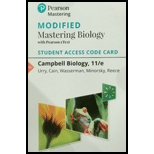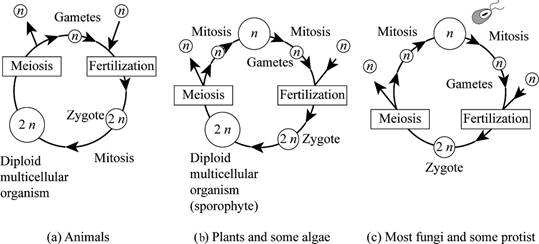
Concept explainers
To determine: Which among the 3 lifecycles (Refer to Fig.13.6 “Three types of sexual lifecycles”, in the textbook) possess “alternation of generation”. Discriminate it with the other 2 lifecycles.
Concept introduction: Many lifecycles have been evolved among the algae (multicellular). The life cycle that is complex includes the alternation of generation. It means there is alternation between the multicellular diploid or the haploid forms. Thus, alternation of generation is applied to only those lifecycles, where the diploid as well as haploid, both stages exists.
Pictorial representation:
Sexual lifecycles of various organisms is represented in Fig.1.

Fig.1 “Three types of sexual lifecycles”
Want to see the full answer?
Check out a sample textbook solution
Chapter 28 Solutions
Modified Mastering Biology with Pearson eText -- Standalone Access Card -- for Campbell Biology
- VISUALIZE Use two different colors to depict the unduplicated chromosomes of species C with larger chromosomes (2n = 8) and species D with slightly smaller chromosomes (2n = 10), and of their F1 hybrid. Is the hybrid likely to be fertile?arrow_forwardWhat distinguishes asexual reproduction from sexual reproduction? What benefit does sexual reproduction confer to species? What is the value of genetic diversity? Why? In what ways does sexual reproduction contribute to diversity? Describe the unpredictability of meiotic partner selection, random distribution, and crossover.arrow_forwardObservation 1: 1 out of 2 first trimester abortuses show abnormal karyotypes with 96% caused by numerical abnormalities and 4% with structural abnormalities. At live birth, 1 out of 160 has abnormal karyotypes with 60% caused by numerical changes. This number increases with fetuses of mothers over 35 years old to 1/50 for total incidence and 85% for numerical changes. Questions: Think of reasons why it is important to maintain the number and structure of chromosomes. Why is maternal age so important?arrow_forward
- WHAT IF? If maternal and paternal chromatids havethe same two alleles for every gene, will crossing overlead to genetic variation?arrow_forwardThe continuity of life is based on heritable information in the form of DNA. In a short essay (100–150 words), explain how chromosome behavior during sexual reproduction in animals ensures perpetuation of parental traits in offspring and, at the same time, genetic variation among offspring.arrow_forwardWHAT IF? What would the human life cycle be likeif we had alternation of generations? Assume that themulticellular diploid stage would be similar in form to anadult human.arrow_forward
- 1. Describe the three modes that prokaryotes can 'obtain' new genes. Be sure to identify similarities and differences between the three modes. How does the concept of new gene introduction change the view that prokaryotes are asexual species? 2. Describe the conditions on Earth that is thought to have favored the evolution of seed plants? What, is a seed and how is it different from a spore?arrow_forwardPlease answer fast 1. What are some challenges still today about reproductive cloning? 2. What are some ways in which a speciation event can occur? 3. What are the other species' definitionsarrow_forwardQ. What are the possible changes in chromosome number and structure that will occur in a living species with six haploid chromosomes ? You can give the phenotypic changes that will occur on a real and / or hypothetical sample.arrow_forward
- Why is variation advantageous to populations? How does this relate to species that reproduce sexually versus those that reproduce asexually? 2. Why is it important that meiosis produces a haploid cell? Hint: think about the result over multiple generations if it did not do this.arrow_forwardWHAT IF? A chicken has 78 chromosomes in its somaticcells. How many chromosomes did the chicken inheritfrom each parent? How many chromosomes are in eachof the chicken’s gametes? How many chromosomes willbe in each somatic cell of the chicken’s offspring?arrow_forwardApply Evolutionary Thinking How do human activities (such as destruction of natural habitats, diversion of rivers, and the construction of buildings) influence the chances that new species of plants and animals will evolve in the future? Frame your answer in terms of the geographical and genetic factors that foster speciation.arrow_forward
 Biology: The Dynamic Science (MindTap Course List)BiologyISBN:9781305389892Author:Peter J. Russell, Paul E. Hertz, Beverly McMillanPublisher:Cengage Learning
Biology: The Dynamic Science (MindTap Course List)BiologyISBN:9781305389892Author:Peter J. Russell, Paul E. Hertz, Beverly McMillanPublisher:Cengage Learning Biology (MindTap Course List)BiologyISBN:9781337392938Author:Eldra Solomon, Charles Martin, Diana W. Martin, Linda R. BergPublisher:Cengage Learning
Biology (MindTap Course List)BiologyISBN:9781337392938Author:Eldra Solomon, Charles Martin, Diana W. Martin, Linda R. BergPublisher:Cengage Learning

